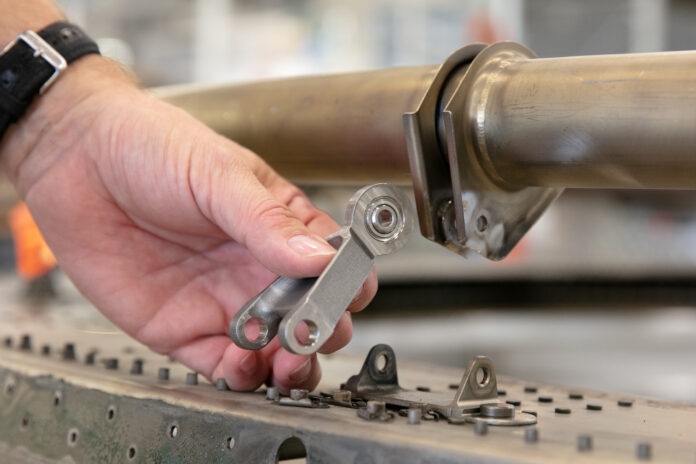
Lufthansa Technik, a company that has been providing maintenance and technical services to VIP and government customers for more than 60 years, and Premium AEROTEC recently joined forces to achieve the development and production of a spare part for use on airplanes. Designed for the IAE-V2500 engine's anti-icing system, the metal 3D printed part has now been granted its official aviation certification from EASA.
This means that, as from now on, Premium AEROTEC will produce the so-called "A-Link" for Lufthansa Technik at its Varel (Germany) site using a 3D printer.
Known for using advanced metal 3D printers from machine manufacturers like GE Additive, and for its involvement in the NextGenAM project, Premium AEROTEC has built up expertise in the development and production of aerostructures made of metal and carbon fiber composites.
A total of nine of these A-Links fix a ring-shaped hot air duct in the engine's inlet cowl, which is thus protected from ice buildup during flight operations. However, the vibrations that occur here during operation cause the A-links to wear at their mounting holes, so that after a few years they are often ripe for replacement.
As the A-Links can be exposed to temperatures of up to 300 degrees Celsius, they are made of titanium. The component is usually manufactured by a forging process to meet the highest requirements for material properties. With AM, and especially Laser Power Bed Fusion (LPBF), Premium AEROTEC and Lufthansa Technik have explored a manufacturing option that does not require jigs and moulds for production. Furthermore, the process can save valuable material, since after 3D printing a material removal is only necessary to a very small extent on some functional surfaces.
However, the properties of the components produced in this way, for example their strength, are heavily dependent on the corresponding additive manufacturing process, the qualification of which must therefore be proven in a complex procedure. To this end, Premium AEROTEC carried out a large number of so-called "print jobs" with test specimens, with constant settings of all process-relevant parameters. This way, it was finally possible to establish a constant and reliable process and to prove that the highest requirements in terms of material properties are also achieved here. In terms of tensile strength, the additively manufactured A-Link is even superior to the original part.
As part of this certification process, Lufthansa Technik has now extended the expertise of its EASA Part 21/J development facility to include additively manufactured metal components. For Premium AEROTEC, the cooperation with Lufthansa Technik is a significant milestone in the field of additive manufacturing, as it is the first time the company has supplied a customer outside the Airbus Group with printed series components. The first A-Links from the cooperation will be used in the Lufthansa fleet, where long-term experience with the new components is to be gained beyond certification.
"We have been producing components for the aircraft cabin, the vast majority of which are made of plastic, using 3D printing for years. Now we are able to demonstrate that structurally relevant metal parts for use outside the cabin can also be manufactured additively and approved for flight operations," said Soeren Stark, Chief Operating Officer of Lufthansa Technik. "In this way, we have not only achieved a cost saving for the component in question, but also defined and qualified all the necessary processes for the application of this groundbreaking manufacturing method for structurally relevant metal parts."
However, the first aviation certification of a load-bearing metal spare part currently represents only a first step for both partners, as its geometry still largely corresponds to the original part. Future developments in the technology will also make it possible to use the advantages of additive manufacturing for targeted optimization of the geometry. Theoretically, there are no limits to the shaping of additively manufactured components, so that they can then be produced much more easily and with less material while retaining the same strength and function. Both partners intend to further develop these possibilities in the near future.
Remember, you can post job opportunities in the AM Industry on 3D ADEPT Media free of charge or look for a job via our job board. Make sure to follow us on our social networks and subscribe to our weekly newsletter: Facebook, Twitter, LinkedIn & Instagram ! If you want to be featured in the next issue of our digital magazine or if you hear a story that needs to be heard, make sure you send it to contact@3dadept.com





